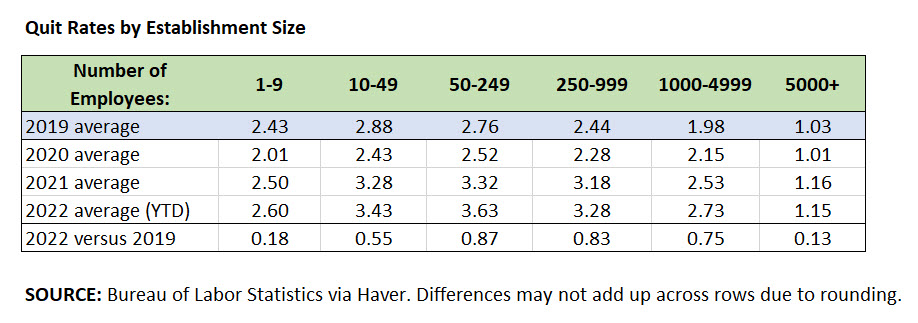Does Business Size Matter in Attracting Workers?
When it comes to attracting workers, does the size of the business matter? Recent data suggest so, but it's not a simple case of bigger being better.
As discussed in earlier posts ("Workers for the Right Wage" and "Hiring Problems Persist"), businesses in every industry have experienced challenges with hiring and keeping workers during the pandemic. However, these hiring challenges might differ according to the size of the business. For example, job seekers whose reservation wages have risen might be more attracted to larger businesses where salaries and benefits have increased relative to smaller businesses over the pandemic.1 On the other hand, small businesses have become more attractive to workers. Picture big-city corporate workers who relocated to small towns during the pandemic and gave up their former jobs to work for small businesses.
"Overall, when looking at both vacancy yields and quit rates, biggest seems best ..."
In this post, we'll look at what the data say about business size and challenges in attracting workers. Data come from the Bureau of Labor Statistics (BLS) Job Openings and Labor Turnover Survey (JOLTS), which reports estimates of job openings, hires and separations by establishment size. The BLS distinguishes between establishments and firms:
- Establishments refer to a single physical location where one predominant activity occurs.
- Firms refer to an establishment or a combination of establishments defined by a unique employer identification number.
For example, two different establishments — an automaker's manufacturing plant and an automaker's corporate headquarters — could belong to the same firm. In the rest of this post, we follow the BLS in talking about differences at the establishment level.2
We interpret success in hiring as one measure of how attractive a business is to prospective workers. As we've done in previous posts, we'll use the hires-per-job opening ratio (also known as the "vacancy yield") as our preferred measure of hiring efficiency. Figure 1 below shows that vacancy yields peaked at the beginning of the pandemic due to a collapse in job openings, then dropped and have remained lower than the pre-pandemic baseline (February 2020) across all size groups. As of April, the smallest gaps are for establishments with 1-9 employees, 250-999 employees and 5,000+ employees, encompassing establishments small and large.
But the monthly observations are noisy. Table 1 below shows how the year-to-date average for 2022 compares with the 2019 pre-pandemic average.
The bottom row suggests that vacancy yields for larger establishments with 1,000 or more workers are closer to their pre-pandemic benchmark than for other size groups. According to this measure, larger firms are more attractive to potential employees.
The attractiveness of a business might also be reflected in how successfully a business keeps workers. As shown in Figure 2 below, quit rates remain higher than pre-pandemic levels across all size groups.
However, as of April, quit rates for the top two size groups (5,000+ employees and 1,000-4,999 employees) appear to be closer to their pre-pandemic levels compared to smaller establishments where the gap in quit rates is over half a percentage point. For example, quit rates for establishments with 250-999 employees remain 1.2 percentage points higher than the February 2020 pre-pandemic baseline.
Averaging out the monthly noise, Table 2 below shows average quit rates by establishment size.
The last row of Table 2 suggests that compared to 2019, the largest establishments (those with 5,000 or more employees) have been the most successful keeping employees, with average quit rates only 0.1 percentage points higher than the pre-pandemic level. But the smallest establishments (those with fewer than 10 employees) have also fared well, with year-to-date average quit rates in 2022 only 0.2 percentage points from their 2019 average levels. In comparison, the other size classifications are seeing quit rate gaps that are notably higher.
Overall, when looking at both vacancy yields and quit rates, biggest seems best, but the smallest establishments are also showing signs of success, with more misery for those in the middle.
Quarterly BLS data on employer costs for employee compensation show that employee compensation at the largest establishments (those with 500 or more workers) was up 12.9 percent in the first quarter of 2022 compared with the fourth quarter of 2019, while growth rates for smaller size groups were under 12 percent over the same period.
According to the BLS, most businesses are single-establishment firms. Also, some multiple-establishment firms may be making case-by-case compensation decisions — such as geography-based cost-of-living adjustments — that vary at the establishment level.
Views expressed in this article are those of the author and not necessarily those of the Federal Reserve Bank of Richmond or the Federal Reserve System.





